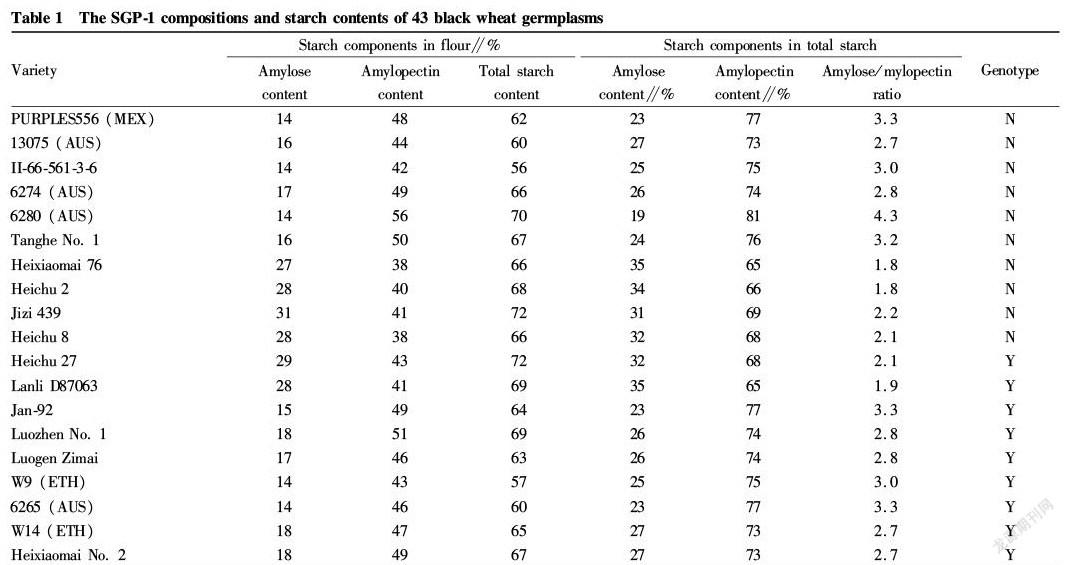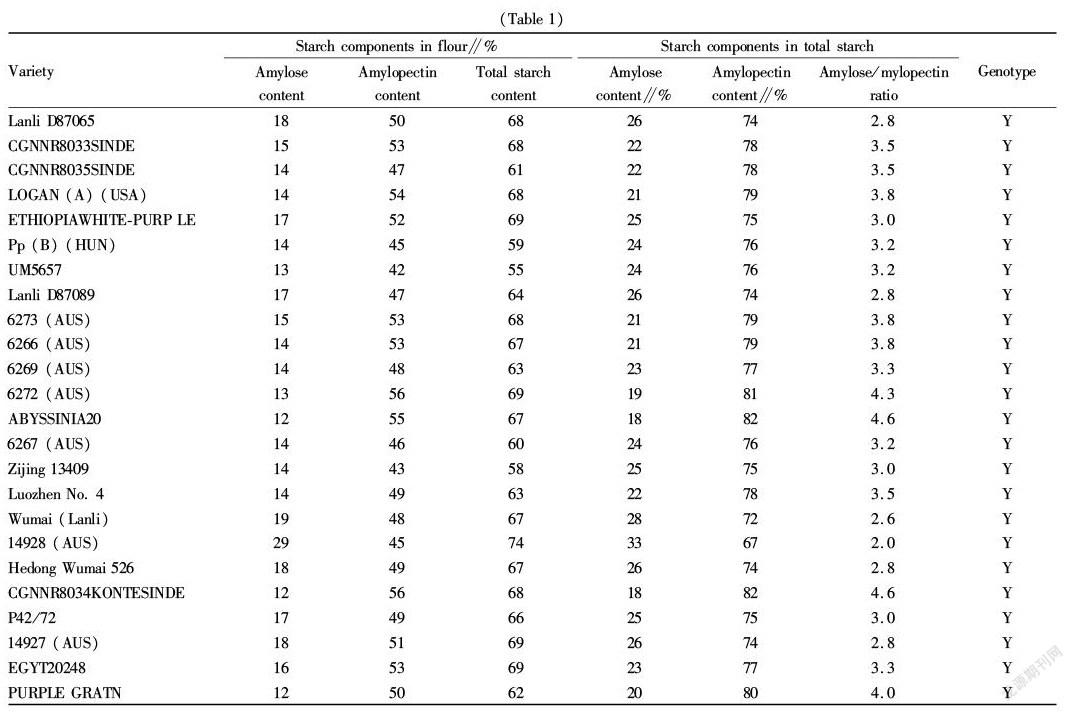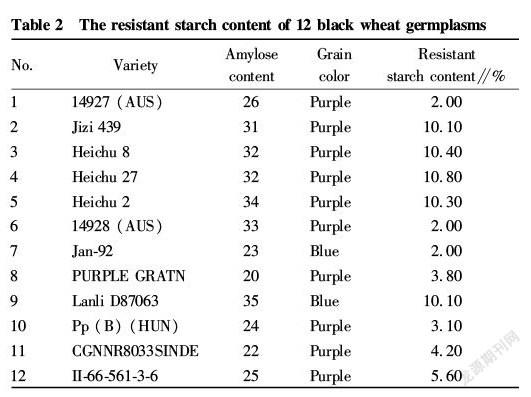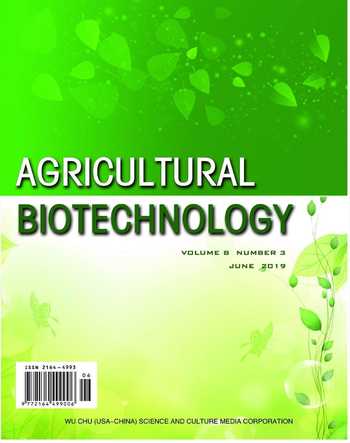Study on Compositions of Grain Starch and SGP-1 Protein in Black Grain Wheat
2019-09-10YaningMENGQiaqiaWANGYelunZHANGSuqueLANGuangweiLIXingpuLIDongyueGU
Yaning MENG Qiaqia WANG Yelun ZHANG Suque LAN Guangwei LI Xingpu LI Dongyue GU



Abstract In view of the lack of wheat genetic resources with high amylose and high resistant starch contents in the present world, the grain starch components and SGP 1 (SGP A1, SGP B1 and SGP D1) protein composition of 43 black kernel wheat genetic resources such as Jizi 439 were identified by SDS PAGE electrophoresis detection. The results showed that 11 materials were lack of SGP A1, and no materials had SGP B1 and SGP D1 deletion. Seven materials were identified to have an amylose content more than 30% of the total starch. A total of 12 materials were selected for the determination of resistant starch content, and five materials were found to have a high resistant starch content. The above results lay a foundation for wheat breeding for high resistant starch content.
Key words Wheat; SGP A1; Amylose; Amylopectin
With the rapid development of the economy and the improvement of peoples living standards, peoples lifestyles and eating habits are undergoing unprecedented changes. In recent years, diet related diseases such as coronary heart disease, cancer (especially rectal cancer and colon cancer) and diabetes have become the main causes of morbidity and mortality in the middle aged and elderly population, and have shown a low age trend. In 2006, the Chinese Association for Student Nutrition & Health Promotion published the "Investigation Report on Nutrition and Health Status of Chinese School age Children and Adolescents", which showed that in the "metabolic syndrome" test involving a series of metabolic indicators such as blood pressure, body mass index, glucose tolerance and blood lipid, 64.1% of children have at least one abnormal indicator.
A large number of medical studies have proved that resistant starch (RS) has good nutritional and physiological functions[1-3]. Increasing the intake of resistant starch in the daily diet can slow down the absorption rate of carbohydrates, and has physiological functions such as controlling body weight, maintaining postprandial blood glucose homeostasis, preventing constipation and colon (rectum) cancer, and lowering blood lipid. RS is mainly formed through the retrogradation of a small part of dextrin and a large part of the amylose and subsequent polymerization. Amylose is the most important component in the formation of resistant starch. However, investigations show that the amylose content of the main wheat varieties currently accounts for only 12% to 35% of the endosperm starch content, while the proportion of amylopectin content is as high as 65% to 88%[4-7]. At present, the breeding and genetic studies of high amylose varieties are seriously inadequate. Wheat is the second largest food crop in China only second to rice, and it is also the traditional staple crop of northern China. Increasing the amylose content of wheat in China and increasing the resistant starch content in the diet are very important to the improvement of the overall health of the public.
The deletion of starch granule protein SGP 1 (including such three subunits as SGP A1, SGP B1 and SGP D1) can cause changes in the quality traits such as the increase of the relative content of amylose. Yamamori et al.[8] used such three single deletion materials as SGP A1, SGP B1 and SGP D1 to obtain SGP 1 tri deletion material by hybridization polymerization, and found that the short amylopectin content in the endosperm increased significantly and the amylose content increased. In this study, with 43 black kernel wheat resources including Jizi 439 as raw materials, the identification of the wheat grain resources with SGP 1 deletion and the study of amylose and resistant starch contents were conducted, with an attempt to provide a basis for the screening of high amylose and high resistant starch molecular breeding materials of wheat.
Materials and Methods
Experimental materials
A total of 43 black wheat resources were tested, including domestic triticale cultivars and eight improved varieties, all of which were provided by the Wheat Resource Department of Institute of Cereal and Oil Crops, Hebei Academy of Agriculture and Forestry Sciences.
Experimental methods
SGP 1 Protein identification
Protein extraction was based on the method of Yamamori M et al.[9], and SDS PAGE electrophoresis was based on the method of Wang[10]. The specific steps were as follows: 30 mg of whole wheat flour was mixed well and added with 0.6 ml of starch rinsing buffer (55 m MTris HCl, pH 6.8, 2.3% SDS, 5% β mercaptoethanol), obtaining a mixture, which was stood at 4 ℃ overnight, and centrifuged at 13 000 r/min for 4 min. (2) After removing the supernatant, 1 ml of starch rinsing buffer was added, stirred well, and centrifuged at 13 000 r/min for 4 min; and after removal of the supernatant, the step was repeated for 3 times. (3) 1 ml of double distilled water was used instead of the starch rinsing buffer to rinse to the precipitate for 2 times according to step (2). (4) 0.6 ml of extraction buffer (prepared by adding 10% glycerol into the starch rinsing buffer) was added to suspend the precipitate, giving a suspension, which was heated in a boiling water bath (90 ℃) for 5-10 min, and then centrifuged for 10-15 min, and the obtained supernatant was loaded for electrophoresis. (5) The electrophoresis was performed for 6 h using 10% separation gel under an initial voltage of 130 V which was improved to 300 V after the bromophenol blue entered the separation gel. And (6) the gel was stained by the silver staining method.
Determination of starch component contents
Determination of amylose and amylopectin contents
The drawing of amylose and amylopectin standard curves and their content determination were performed according to the method of Wang[11]. The amylose and amylopectin standard solutions were prepared from potato amylose and amylopectin pure products (Sigma). The wavelengths for amylose and amylopectin determination were selected to be 630 and 560 nm, respectively, and the reference wavelengths were selected to be 470 and 730 nm, respectively. The amylose, amylopectin and total starch contents of the flour and the relative contents of amylose and amylopectin in the starch were calculated according to the mass of amylose and amylopectin measured per 100 mg of flour.
Determination of resistant starch content
The determination was performed according to the method provided by the Irish company Megazyme. (10±0.05) mg of the sample was accurately weighed, added with a 10 mg/ml mixed working solution (pancreatic α amylase + 3 IU/ml AGM), and incubated in a 37 ℃ water bath shaker for 16 h. The absorbance of the solution was determined in a spectrophotometer using a glucose detection kit at wavelength 510 nm, and the content of resistant starch was calculated.
Results and Analysis
Molecular identification of black kernel wheat resources with SGP 1 deletion
Identification of SGP 1 protein was performed on the 43 black kernel wheat materials from different sources by SDS PAGE electrophoresis. The results showed that 11 materials among them, namely PURPLES556 (MEX), 13075 (AUS), II 66 561 3 6, 6274 (AUS), 6280 (AUS), Tanghe No. 1, Heixiaomai 76, Heichu 8, Jizi 439, Heichu 2 and Heichu 27, suffered from SGP A1 deletion; and no materials were identified to have SGP B1 and SGP D1 deletion (Table 1). Among the materials with gene deletion, Heichu 8, Jizi 439, Heichu 2 and Hechu 27 had the agronomic traits such as plant height and maturity close to the current promoted varieties.
Grain starch components of black kernel wheat resources
The contents of starch components in the 43 black kernel wheat resources were determined. The results showed that among the 11 materials with SGP A1 deletion, there were five materials with more than 30% of amylose in the total starch content, which were Heichu 8, Heixiaomai 76, Heichu 2, Heichu 27 and Jizi 439, accounting for 45.45% of the total amount of the materials with SGP A1 deletion. However, among the remaining 32 materials containing SGP A1, only two materials had the proportion of amylose to total starch more than 30%, which were Lanli D87063 and 14928 (AUS), accounting for 6.25% of the total materials containing SGP A1. It can be seen that in the black kernel wheat resources, the probability of obtaining high amylose content from the deletion materials with SGP A1 is greater. A total of 12 materials were tested for resistant starch content. The results (Table 2) showed that five black kernel wheat materials (Jizi 439, Heichu 8, Heichu 27, Hechu 2 and Lanli D87063) had a resistant starch content larger than 10%, which was significantly higher than other materials.
Conclusions and Discussion
The mutation and deletion of wheat SGP 1 directly leads to changes in starch components in the endosperm[8]. Related studies have shown that the deletion of SGP 1 increases the content of short chain amylopectin, while the content of short chain amylopectin exhibits the characteristics of amylose. Therefore, from the respect of phenotype, the amylose content increases due to the deletion of SGP 1, i.e., the apparent amylose content increases[8]. This situation also occurs in high amylose maize[12]. Among the 43 black kernel wheat resources in this study, 45.45% of the materials with SGP A1 deletion had an amylose content more than 30% of the total starch content, while in the common materials, only 6.25% of the materials had an amylose content more than 30% of the total starch content. This law is consistent with the results of previous studies.
A total of 11 materials with SGP A1 deletion were identified from the 43 black kernel wheat resources tested, and no materials had SGP B1 and SGP D1 deletion, which lays a material foundation for high value added breeding of wheat. Seven materials were determined to have an amylose content accounting for more than 30% of the total starch content, and among them, materials with better agronomic traits included Heichu 8, Heichu 2 and Heichu 27. A total of 12 materials were selected for determination of resistant starch content, and five materials, namely Jizi 439, Heichu 8, Heichu 27, Heichu 2 and Lanli D87063, were found to have a high resistant starch content.
References
[1] RASHMI S, UROOJ A. Effect of processing on nutritionally important starch fraction in rice varieties[J]. International Journal of Food Sciences and Nutrition, 2003, 54 (1): 27-36.
[2] TOPPING DL, CLIFTON PM. Short chain fatty acids and human colonic function: roles of resistant starch and nonstarch polysaccharides[J]. Physiological Reviews, 2001, 81(3): 1031-1064.
[3] JOBLING S. Improving starch for food and industrial applications[J]. Current Opinionin Plant Biology, 2004, 7 (2): 210-218.
[4] BOGGINI G, CATTANEO M, PAGANONI C, et al. Genetic variation for waxy proteins and starch properties in Italian wheat germplasm[J]. Euphytica, 2001, 119 (1-2): 113-116.
[5] ZHANG YL, MENG YN, LI XP, et al. Effects of grain quality and starch components on flour paste properties[J]. Acta Agriculturae Boreali Sinica, 2016, 31(S1): 317-322. (in Chinese)
[6] ZHANG YL, MENG YN, LI XP, et al. Analysis on genotype of starch granule protein 1 mutations and their agronomy traits and qualities[J]. Journal of Hebei Agricultural Sciences, 2015, 19 (3): 55-59. (in Chinese)
[7] ZHANG YL, DU HY, LI XP, et al. Effect of SGP A1 null on starch quality in common wheat[J]. Scientia Agricultura Sinica, 2010, 43 (12): 2590-2594. (in Chinese)
[8] YAMAMORI M, FUJITA S, HAYAKAWA K, et al. Genetic elimination of a starch granule protein, SGP 1, of wheat generates an altered starch with apparent high amylose[J]. TAG Theoretical and Applied Genetics, 2000, 101 (1-2): 21-29.
[9] YAMAMORI M, ENDO TR. Variation of starch granule proteins and chromosome mapping of their coding genes in common wheat[J]. Theoretical and Applied Genetics, 1996, 93: 275-281.
[10] WANG JZ. Protein technology manual[M]. Beijing: Science Press, 2000. (in Chinese)
[11] WANG LA. Method for determining amylose in rice by double beam dual wavelength spectrophotometer[J]. Cereal & Feed Industry, 1999, (3): 45-46. (in Chinese)
[12] BOYER CD, GARWOOD DL, SHANNON JC. The interaction of the amylose extender and waxy mutants of maize (Zea mays L.)[J]. Strke, 1976, 28: 405-410.
[13] KONIK ROSE C, THISTLETON J, CHANVRIER H, et al. Effects of starch synthase IIa gene dosage on grain, protein and starch in endosperm of wheat[J]. Theoretical and Applied Genetics, 2007, 115(8): 1053-1065.
[14] EDWARDS A, MARSHALL J, SIDEBOTTOM C, et al. Biochemical and molecular characterization of anovel starch synthase from potato tubers[J]. The Plant Journal: For Cell and Molecular Biology, 1995, 8 (2): 283-294.
杂志排行
农业生物技术(英文版)的其它文章
- Study on Chemical Composition of the Ethyl Acetate Extract of Pratia
- Effects of Different Selenium Fertilizer Types on Selenium Content and Quality of “Lingfeng” Grapes
- Protoplast Culture and Its Application in Fruit Breeding
- Indexes of Tree Structure of Cylindrical Pear Orchards at the Sapling Stage
- Carbon Storage and Distribution of the Mature Pinus massoniana Plantation in Northwest Guangxi
- Pollution and Quality Control of Mycotoxins in Foods and Feeds
